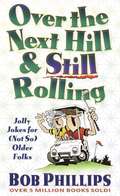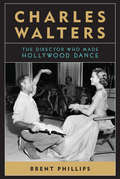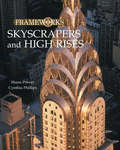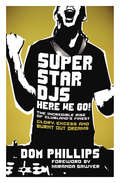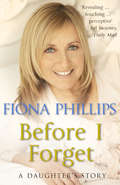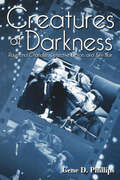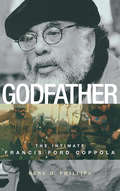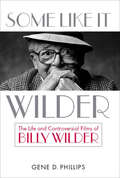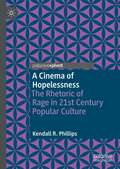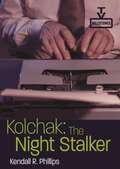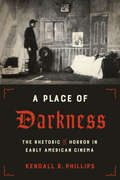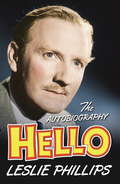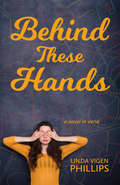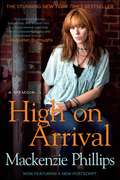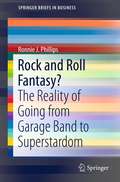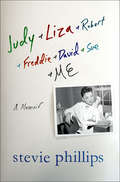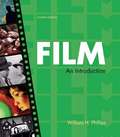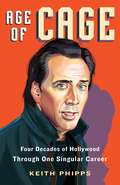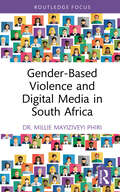- Table View
- List View
Over the Next Hill & Still Rolling
by Bob Phillips[From the back cover] You know you're over the hill when... ...you have no guilt about appearing in pajamas and flicking the lights on and off when it's time for dinner guests to leave. ...you hear the term "CD" and you think "certificate of deposit, not "compact disc." ...actions creak louder than words. ...a trip down memory lane requires a map. ...your spouse still snores, but now you can't hear it. A laugh a day keeps the wrinkles away! So ease yourself into the rocking chair, grab your afghan, and adjust your reading glasses for this rib-tickling collection of jokes, puzzles, quotes, quizzes, and sage advice from Bob Phillips, the (aging) master of humor.
Charles Walters: The Director Who Made Hollywood Dance (Screen Classics)
by Brent PhillipsFrom the trolley scene in Meet Me in St. Louis (1944) to Fred Astaire and Ginger Rogers's last dance on the silver screen ( The Barkleys of Broadway, 1949) to Judy Garland's timeless, tuxedo-clad performance of "Get Happy" ( Summer Stock, 1950), Charles Walters staged the iconic musical sequences of Hollywood's golden age. During his career, this Academy Award--nominated director and choreographer showcased the talents of stars such as Gene Kelly, Doris Day, Debbie Reynolds, and Frank Sinatra. However, despite his many critical and commercial triumphs, Walters's name often goes unrecognized today.In the first full-length biography of Walters, Brent Phillips chronicles the artist's career, from his days as a featured Broadway performer and protégé of theater legend Robert Alton to his successes at Metro-Goldwyn-Mayer. He takes readers behind the scenes of many of the studio's most beloved musicals, including Easter Parade (1948), Lili (1953), High Society (1956), and T he Unsinkable Molly Brown (1964). In addition, Phillips recounts Walters's associations with Lucille Ball, Joan Crawford, and Gloria Swanson, examines the director's uncredited work on several films, including the blockbuster Gigi (1958), and discusses his contributions to musical theater and American popular culture.This revealing book also considers Walters's personal life and explores how he navigated the industry as an openly gay man. Drawing on unpublished oral histories, correspondence, and new interviews, this biography offers an entertaining and important new look at an exciting era in Hollywood history.
Skyscrapers and High Rises (Frameworks (group 1) Ser.)
by Cynthia Phillips Shana PriwerThis work includes a brief history of skyscrapers as well as chapters on elevators and communications, facades and facing, mechanical and electrical systems, forces of nature, and much more.
Superstar DJs Here We Go!: The Rise and Fall of the Superstar DJ
by Dom Phillips"It was about larging it. It was about pulling out a wad of 20s when you were buying your champagne at the bar. It was about buying your cocaine in an eight ball. It was about wearing designer clothes. At that top tier of that club scene, it was about giving it loads."With a foreword by music journalist, Miranda Sawyer, Superstar DJs Here We Go! is the full, unexpurgated story of the biggest pop culture phenomenon of the 1990s: the rise and fall of the superstar DJ.During the 1990s big names such as Sasha, Jeremy Healy, Fatboy Slim, Dave Seaman, Nicky Holloway, Judge Jules, and Pete Tong exploded out of acid house, becoming international jetsetters, flying all over the world just to play a few hours and commanding up to £140,000 a night. The plush, heavily branded 'superclubs' where they performed - clubs like Cream, Ministry, Renaissance and Gatecrasher - were filled with thousands of adoring clubbers, roaring their approval of their DJ gods. For the DJs and promoters, it was a licence to print money and live like a rock star. For clubbers, it was a hedonistic utopia where anyone and everyone could come together to look fabulous, take drugs, and dance the night away. But underneath the shiny surface lurked a darker side, a world of cynical moneymaking, rampant egos and cocaine-fuelled self-indulgence that eventually spiralled out of control leaving behind burnt-out DJs, jobless promoters and a host of bittersweet memories.They went from having the clubbing world at their feet to the world's biggest comedown. Dom Phillips - former editor of clubbers' bible Mixmag - reveals an enthralling and at times jaw-dropping account of flawed people, broken dreams and what really happens when it all goes Pete Tong.
Before I Forget
by Fiona PhillipsFiona Phillips is one of our best-loved television presenters. Well-known for being warm, chatty and down to earth, she attended her local comprehensive in Southampton before studying English in Birmingham. For over twelve years she presented GMTV, during which time she interviewed some of the most famous and influential people on the planet, from film stars to royalty, politicians to local heroes. But in August 2008 Fiona announced that she was to quit the job she loved, revealing that her father, Phil, had been diagnosed with Alzheimer's just a year after her mother had died of the same disease and that she had decided to devote more time to him and to her family. Before I Forget is a wonderfully honest account of growing up in the 1960s and 70s within a complex family. During her childhood her father could sometimes be distant and demanding which both saddened her and drove her to succeed, her mother always the devoted wife and the steady heart of the family. When Fiona lands the job at GMTV she revels in how proud they are of her achievement. When her mother and then her father succumb to Alzheimer's we share in Fiona's sadness as she movingly describes watching them fade away, one moment interviewing George Clooney the next taking a call from Pembrokeshire Social Services to say that her mother had wandered away from her care home.Before I Forget is an extraordinary book which will resonate with Fiona's millions of fans and the millions of people who day-by-day are going through, or have gone through, the same experiences.
Creatures of Darkness: Raymond Chandler, Detective Fiction, and Film Noir
by Gene D. PhillipsMore than any other writer, Raymond Chandler (1888-1959) is responsible for raising detective stories from the level of pulp fiction to literature. Chandler's hard-boiled private eye Philip Marlowe set the standard for rough, brooding heroes who managed t
Godfather: The Intimate Francis Ford Coppola
by Gene D. PhillipsWITH A FOREWORD BY WALTER MURCH Gene Phillips blends biography, studio history, and film criticism to complete the most comprehensive work on Coppola ever written. The force behind such popular and critically acclaimed films as Apocalypse Now and the Godfather trilogy, Coppola has imprinted his distinct style on each of his movies and on the landscape of American popular culture. In Godfather, Phillips argues that Coppola has repeatedly bucked the Hollywood "factory system" in an attempt to create distinct films that reflect his own artistic vision -- often to the detriment of his career and finances. Phillips conducted interviews with the director and his colleagues and examined Coppola's production journals and screenplays. Phillips also reviewed rare copies of Coppola's student films, his early excursions into soft-core pornography, and his less celebrated productions such as One from the Heart and Tucker: The Man and His Dream. The result is the definitive assessment of one of Hollywood's most enduring and misunderstood mavericks.
Some Like It Wilder: The Life and Controversial Films of Billy Wilder (Screen Classics #Sccl)
by Gene D. PhillipsA biography of the six-time Oscar-winning director of films like Some Like It Hot and Double Indemnity, featuring analysis of his work.Although his career spanned fifty years and included more than fifty films, Austrian-American film director Billy Wilder (1906-2002) may be best known for the legendary shot of Marilyn Monroe’s dress billowing over a subway grating in The Seven Year Itch (1955). This “shot seen round the world” is representative not only of Hollywood’s golden era of cinema but also of one of its most prolific and brilliant directors. Wilder, whose filmography includes such classics as Sunset Boulevard (1950), Sabrina (1954), Witness for the Prosecution (1957), and Some Like It Hot (1959), is often remembered for his versatility, biting wit, and passion for challenging social and moral conventions.Author Gene D. Phillips departs from the traditional biography in Some Like It Wilder, offering new insights into the acclaimed director’s professional and private life. In preparation for the book, Phillips conducted personal interviews with Wilder and other key players from the legendary director’s life and times. Phillips’s unique combination of analysis and biographical detail brings Wilder to life, as both an artist and man.Phillips traces Wilder’s path from Berlin, where he worked as a scriptwriter for one of the city’s largest studios, to Hollywood, where he would quickly establish himself as a premier film director. Forming a partnership with writer-producer Charles Brackett, Wilder directed the classic films Five Graves to Cairo (1943), Double Indemnity (1945), and The Lost Weekend (1945), which earned Academy Awards for best picture, best director, and best screenplay. During the 1960s, Wilder continued to direct and produce controversial comedies, including Kiss Me Stupid (1964) and The Apartment (1960). The Apartment brought Wilder another round of Oscars for best picture, best director, and best screenplay.Wilder’s maverick approach and independent artistic vision pushed boundaries and ensured his legacy as one of the Hollywood greats. Sharply written, Some Like It Wilder serves as a comprehensive companion to Wilder’s films, offering a personalized and heartfelt account of the life and genius of this compelling director.Praise for Some Like It Wilder“Featuring Gene D. Phillips’ unique, in-depth critical approach, Some Like It Wilder . . . provides a groundbreaking overview of a filmmaking icon . . . . This definitive biography reveals that Wilder was, and remains, one of the most influential directors in filmmaking.” —Turner Classic Movies“[Phillips] goes beyond the surface and deep into the complex mind and soul of the famous film director . . . . This book is, in my view, definitive.” —Vincent LoBrutto, author of Martin Scorsese: A Biography
Barrie Kosky’s Transnational Theatres (Global Germany in Transnational Dialogues)
by James Phillips John R. SevernThis book, the first of its kind, surveys the career of the renowned Australian-German theatre and opera director Barrie Kosky. Its nine chapters provide multidisciplinary analyses of Barrie Kosky’s working practices and stage productions, from the beginning of his career in Melbourne to his current roles as Head of the Komische Oper Berlin and as a guest director in international demand. Specialists in theatre studies, opera studies, musical theatre studies, aesthetics, and arts administration offer in-depth accounts of Kosky’s unusually wide-ranging engagements with the performing arts – as a director of spoken theatre, operas, musicals, operettas, as an adaptor, a performer, a writer, and an arts manager. Further, this book includes contributions from theatre practitioners with first-hand experience of collaborating with Kosky in the 1990s, who draw on interviews with members of Gilgul, Australia’s first Jewish theatre company, to document this formative period in Kosky’s career. The book investigates the ways in which Kosky has created transnational theatres, through introducing European themes and theatre techniques to his Australian work or through bringing fresh voices to the national dialogue in Germany’s theatre landscape. An appendix contains a timeline and guide to Kosky’s productions to date.
Papa John: The Autobiography Of John Phillips
by John Phillips Jim JeromeSex, drugs, and rock 'n ' roll. It was the anthem of the sixties. The psychedelic code by which many lived --and died. And John Phillips, legendary founder and songwriter of the Mamas and the Papas, experienced it all. Now Phillips takes us on a dizzying roller-coaster ride from stardom in L.A. to drug busts in the Big Apple. In an intimate, gritty, all- too-true self-portrait, he offers a startling, reflective look at the turbulent sixties and beyond.
A Cinema of Hopelessness: The Rhetoric of Rage in 21st Century Popular Culture (Rhetoric, Politics and Society)
by Kendall R. PhillipsThis book explores the circulation of anger and hostility in contemporary American culture with particular attention to the fantasy of refusal, a dream of rejecting all the structures of the contemporary political and economic system. Framing the question of public sentiment through the lens of rhetorical studies, this book traces the circulation of symbols that craft public feelings in contemporary popular cinema. Analyzing popular twenty-first century films as invitations to a particular way of feeling, the book delves into the way popular sentiments are circulated and intensified. The book examines dystopian films (The Purge, The Cabin in the Woods), science fiction (Snowpiercer), and superhero narratives (the Marvel Cinematic Universe and Joker). Across these varied films, an affective economy that emphasizes grief, betrayal, refusal, and an underlying rage at the seeming hopelessness of contemporary culture is uncovered. These examinations are framed in terms of ongoing political protests ranging from Occupy Wall Street, the Tea Party, Black Lives Matter, and the 6th January 2021 invasion of the US Capitol Building.
Kolchak: The Night Stalker (TV Milestones Series)
by Kendall R. PhillipsBefore Buffy the Vampire Slayer or The X-Files, there was Carl Kolchak, a world-weary Chicago newspaper reporter with a cheap, seersucker suit and a penchant for uncovering monsters lurking in every corner. Kolchak first appeared on American screens in the 1972 ABC television movie The Night Stalker, which was then the most-watched television movie in history. The success of this initial offering led to a sequel, The Night Strangler, and a television series, Kolchak: The Night Stalker, that ran from 1974 until 1975. By carefully focusing on the historical and artistic contexts in which it emerged, Kendall R. Phillips offers insights into the way the series both reflected contemporary horror narratives and changed them. Ultimately, the series proved influential for later television horror shows based not only on what it did right but on the mistakes future creators would learn to avoid. The enduring impact of the series on current television horror continues to draw more and more individuals into its robust fanbase, and these fans continue to consume and create new narratives of their favorite monster-hunting reporter even fifty years after he first appeared.
A Place of Darkness: The Rhetoric of Horror in Early American Cinema
by Kendall R. Phillips&“An illuminating history . . . it&’s clear that the right story can still terrify us; A Place of Darkness is a primer on how the movies learned to do it.&” —NPR Horror is one of the most enduringly popular genres in cinema. The term &“horror film&” was coined in 1931 between the premiere of Dracula and the release of Frankenstein, but monsters, ghosts, demons, and supernatural and horrific themes have been popular with American audiences since the emergence of novelty cinematographic attractions in the late 1890s. A Place of Darkness illuminates the prehistory of the horror genre by tracing the way horrific elements and stories were portrayed in films prior to the introduction of the term &“horror film.&” Using a rhetorical approach that examines not only early films but also the promotional materials for them and critical responses to them, Kendall R. Phillips argues that the portrayal of horrific elements was enmeshed in broader social tensions around the emergence of American identity and, in turn, American cinema. He shows how early cinema linked monsters, ghosts, witches, and magicians with Old World superstitions and beliefs, in contrast to an American way of thinking that was pragmatic, reasonable, scientific, and progressive. Throughout the teens and twenties, Phillips finds, supernatural elements were almost always explained away as some hysterical mistake, humorous prank, or nefarious plot. The Great Depression of the 1930s, however, constituted a substantial upheaval in the system of American certainty and opened a space for the reemergence of Old-World gothic within American popular discourse in the form of the horror genre, which has terrified and thrilled fans ever since. &“[A] fascinating read.&” —Sublime Horror
A Place of Darkness: The Rhetoric of Horror in Early American Cinema
by Kendall R. Phillips&“An illuminating history . . . it&’s clear that the right story can still terrify us; A Place of Darkness is a primer on how the movies learned to do it.&” —NPR Horror is one of the most enduringly popular genres in cinema. The term &“horror film&” was coined in 1931 between the premiere of Dracula and the release of Frankenstein, but monsters, ghosts, demons, and supernatural and horrific themes have been popular with American audiences since the emergence of novelty cinematographic attractions in the late 1890s. A Place of Darkness illuminates the prehistory of the horror genre by tracing the way horrific elements and stories were portrayed in films prior to the introduction of the term &“horror film.&” Using a rhetorical approach that examines not only early films but also the promotional materials for them and critical responses to them, Kendall R. Phillips argues that the portrayal of horrific elements was enmeshed in broader social tensions around the emergence of American identity and, in turn, American cinema. He shows how early cinema linked monsters, ghosts, witches, and magicians with Old World superstitions and beliefs, in contrast to an American way of thinking that was pragmatic, reasonable, scientific, and progressive. Throughout the teens and twenties, Phillips finds, supernatural elements were almost always explained away as some hysterical mistake, humorous prank, or nefarious plot. The Great Depression of the 1930s, however, constituted a substantial upheaval in the system of American certainty and opened a space for the reemergence of Old-World gothic within American popular discourse in the form of the horror genre, which has terrified and thrilled fans ever since. &“[A] fascinating read.&” —Sublime Horror
Hello: The Autobiography
by Leslie PhillipsThe autobiography of a true national treasure, an actor who has featured in more British Number One box office smashes than anyone else.Leslie Phillips's story begins with a poverty-stricken childhood in north London, made all the worse when his father died when Leslie was just ten years old. Soon after, he began his acting career, and since then he has worked with all the greats, from Laurence Olivier to Steven Spielberg.Best known for his comic roles in the Carry On and Doctor series, he took the decision in later life to take on more serious roles in films such as Empire of the Sun, Out of Africa and Scandal, as well as performing in plays such as The Cherry Orchard.Packed with hilarious anecdotes, in this long-awaited autobiography he recalls some of the great characters he has worked with, and also highlights how different he is in real life from his onscreen persona as a bounder. It is a fascinating story, brilliantly told.
Hello: The Autobiography
by Leslie PhillipsThe autobiography of a true national treasure, an actor who has featured in more British Number One box office smashes than anyone else.Leslie Phillips's story begins with a poverty-stricken childhood in north London, made all the worse when his father died when Leslie was just ten years old. Soon after, he began his acting career, and since then he has worked with all the greats, from Laurence Olivier to Steven Spielberg.Best known for his comic roles in the Carry On and Doctor series, he took the decision in later life to take on more serious roles in films such as Empire of the Sun, Out of Africa and Scandal, as well as performing in plays such as The Cherry Orchard.Packed with hilarious anecdotes, in this long-awaited autobiography he recalls some of the great characters he has worked with, and also highlights how different he is in real life from his onscreen persona as a bounder. It is a fascinating story, brilliantly told.
Behind These Hands
by Linda Vigen Phillips"A richly woven, unforgettable symphony of feelings and words" –Kirkus Reviews (Starred Review)Piano prodigy Claire Fairchild, 14, has always known music would be her life. So when she has the opportunity to enter a prestigious contest, she goes all in—until she realizes she’s also competing against Juan, a close childhood friend and one of the most talented musicians she knows. It doesn’t help that her thoughts about him are turning romantic.When Claire and her family receive a devastating blow from Batten disease, her world enters a tailspin. Claire decides her musical goals no longer seem relevant.She can’t reconcile the joy that music would bring to her life while her brothers succumb to an early and ugly death. Her decision puts everything at risk: her friendship with Juan, her parents’ expectations, and her own happiness.After Claire accompanies a friend on a school newspaper assignment, she meets a centenarian with a surprising musical past and only one regret in life. Claire knows something in her life has to change before it’s too late, but she’s not sure she has the courage to take the next step.
High On Arrival
by Mackenzie PhillipsNot long before her fiftieth birthday,Mackenzie Phillips walked into Los Angeles International Airport. She was on her way to a reunion for One Day at a Time, the hugely popular 70s sitcom on which she once starred as the lovable rebel Julie Cooper. Within minutes of entering the security checkpoint, Mackenzie was in handcuffs, arrested for possession of cocaine and heroin. Born into rock and roll royalty, flying in Learjets to the Virgin Islands at five, making pot brownies with her father's friends at eleven, Mackenzie grew up in an all-access kingdom of hippie freedom and heroin cool. It was a kingdom over which her father, the legendary John Phillips of The Mamas & the Papas, presided, often in absentia, as a spellbinding, visionary phantom. When Mackenzie was a teenager, Hollywood and the world took notice of the charming, talented, precocious child actor after her star-making turn in American Graffiti. As a young woman she joinedthe nonstop party in the hedonistic pleasure dome her father created for himself and his fellow revelers, and a rapt TV audience watched as Julie Cooper wasted away before their eyes. By the time Mackenzie discovered how deep and dark her father's trip was going, it was too late. And as an adult, she has paid dearly for a lifetime of excess, working tirelessly to reconcile a wonderful, terrible past in which she succumbed to the power of addiction and the pull of her magnetic father. As her astounding, outrageous, and often tender life story unfolds, the actor-musician-mother shares her lifelong battle with personal demons and near-fatal addictions. She overcomes seemingly impossible obstacles again and again and journeys toward redemption and peace. By exposing the shadows and secrets of the past to the light of day, the star who turned up High on Arrival has finally come back down to earth -- to stay.
California Dreamin': The True Story of the Mamas and the Papas
by Michelle PhillipsIt's all here--the years of poverty, struggle, and obscurity... the fateful first meeting with record producer Lou Adler... the incredible burst of work and creativity that led to their first smash album... the band's meteoric rise to stardom ("Monday, Monday" sold 160,000 copies the first day it was released)... the wildly decadent life-style that embraced LSD and free love... the burnout, the arguments, and the final bitterness and breakup of the band.
Rock and Roll Fantasy?
by Ronnie PhillipsWe are in an era where developments in both technology and musical style have coalesced to produce the greatest period of change in the music industry since the invention of recorded sound. Globalization, the Internet, and digital technology are now opening up possibilities for more artists to be innovative and financially successful. But new music requires new ways of doing business. For more artists to be better off requires new business models to replace those that dominated the 20th century. Integrating insights from economics, management, and intellectual property law, the author explores the dynamics of entrepreneurship and innovation in the music industry, and offers such provocative assessments as these: · The Beatles might never have broken up if they had the kind of two-tier contracts - as band members and as solo artists - that are common in the music industry today. · Buddy Holly would likely have avoided his tragic death in a plane crash at age 22 if his 1959 tour had been sponsored by a company like Coca Cola because today's corporatized tours are vastly better financed and organized than the haphazard efforts of the 1950s. · The economic value of albums by the likes of Elvis and Michael Jackson has risen significantly since their deaths - the ironic byproduct of the way their behavior tarnished their own brands while they were alive. · Diana Ross might never have quit The Supremes if she had known that one-third of the artists in the 1960s who quit the group had charting careers of only one year. · Thomas Edison's invention of the phonograph led to the modern record industry, but he is really the godfather of computer programs like Garageband which have created home recording studios. The collapse of the Soviet Union threatened the sound of rock and roll but an American entrepreneur saved the day.
Judy & Liza & Robert & Freddie & David & Sue & Me...
by Stevie PhillipsNo star burned more ferociously than Judy Garland. And nobody witnessed Garland's fierce talent at closer range than Stevie Phillips. During the Mad Men era, Stevie Philips was a young woman muscling her way into the manscape of Manhattan's glittering office towers. After a stint as a secretary, she began working for Freddie Fields and David Begelman at Music Corporation of America (MCA) under the glare of legendary über-agent Lew Wasserman. When MCA blew apart, Fields and Begelman created Creative Management Associates (CMA), and Stevie went along. Fields convinced Garland to come on board, and Stevie became, as she puts it, "Garland's shadow," putting out fires-figurative and literal-in order to get her to the next concert in the next down-and-out town. Philips paints a portrait of Garland at the bitter end and although it was at times a nightmare, Philips says, "She became my teacher," showing her "how to" and "how not to" live.Stevie also represented Garland's fiercely talented daughter, Liza Minnelli, as well as Robert Redford, Paul Newman, Henry Fonda, George Roy Hill, Bob Fosse, Cat Stevens, and David Bowie. She produced both films and Broadway shows and counted her colleague, the legendary agent Sue Mengers, among her closest confidantes. Now Stevie Phillips reveals all in Judy & Liza & Robert & Freddie & David & Sue & Me..., a tough-talking memoir by a woman who worked with some of the biggest names in show business. It's a helluva ride.
Audition For Your Career, Not The Job: Mastering The On-camera Audition
by Tim Phillips Stephanie GunningYou’ve got a big audition lined up for a role in a film or on a television series. What do you do now? AUDITION FOR YOUR CAREER, NOT THE JOB covers steps you can take and specific skills you can put to use immediately to feel more confident about your performance in your next audition and make a great and lasting impression on casting directors and producers. If your work is consistently first-rate and memorable, then every on-camera audition is an opportunity to advance your acting career. This book will teach you techniques that improve your ability to read and interpret the sides quickly, helping you to trust your instincts and craft strong, bold, specific acting choices, and setting you up for an active and profitable career.
Film: An Introduction
by William H. PhillipsFilm: An Introduction covers the movies students know and the films their instructors want them to know -- including the silent classics of D. W. Griffith and Sergei Eisenstein, the Hong Kong cinema of John Woo, the documentaries of Errol Morris and Michael Moore, and the contemporary films of Quentin Tarantino and Peter Jackson. Through meticulous coverage, an unmatched art program with over 500 frame enlargements, accessible language, and unique study tools, Film helps beginning students develop the critical skills they need to analyze films and understand the medium in all its variety.
Age of Cage: Four Decades of Hollywood Through One Singular Career
by Keith Phipps“Age of Cage might be the closest we will get to understanding the singular beauty of each of Nic Cage’s always electric performances. You are holding the Rosetta Stone for Cage. Enjoy it.”—Paul Scheer, actor, writer and host of the How Did This Get Made? and Unspooled podcastsIcon. Celebrity. Artist. Madman. Genius. Nicolas Cage is many things, but love him, or laugh at him, there's no denying two things: you’ve seen one of his many films, and you certainly know his name. But who is he, really, and why has his career endured for over forty years, with more than a hundred films, and birthed a million memes?Age of Cage is a smart, beguiling book about the films of Nicolas Cage and the actor himself, as well as a sharp-eyed examination of the changes that have taken place in Hollywood over the course of his career. Critic and journalist Keith Phipps draws a portrait of the enigmatic icon by looking at—what else?—Cage’s expansive filmography.As Phipps delights in charting Cage’s films, Age of Cage also chronicles the transformation of film, as Cage’s journey takes him through the world of 1980s comedies (Valley Girl, Peggy Sue Got Married, Moonstruck), to the indie films and blockbuster juggernauts of the 1990s (Wild at Heart, Leaving Las Vegas, Face/Off, Con Air), through the wild and unpredictable video-on-demand world of today. Sweeping in scope and intimate in its profile of a fiercely passionate artist, Age of Cage is, like the man himself, surprising, insightful, funny, and one of a kind. So, snap out of it, and enjoy this appreciation of Nicolas Cage, national treasure.
Gender-Based Violence and Digital Media in South Africa (Routledge Focus on Media and Cultural Studies)
by Millie Mayiziveyi PhiriThis book presents a new paradigm for attending to gender-based violence (GBV) social media discourse among marginalised Black women in South Africa. Focusing on the intersections of television and social media, the study charts the morphing and merging of the “inside” of the soap opera and the “outside” of the real world, amid a rise in feminist social media activism. The analysis begins with coverage of gender-based violence in a long-running South African soap opera and social media discussion of these issues, in parallel with real-world events and the collective social media response. The author offers pertinent insights into audiences in sub-Saharan Africa, presenting a new feminist trajectory for women and activism in the region. Offering new insights into an important issue, this book will be of interest to scholars and students of gender, cultural studies, film studies, television studies, sociology, development studies, feminism, media, and journalism.
